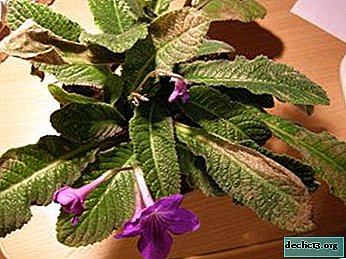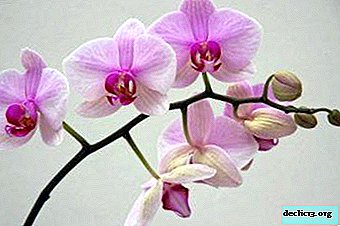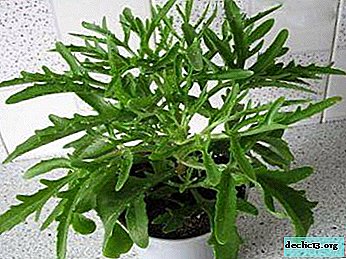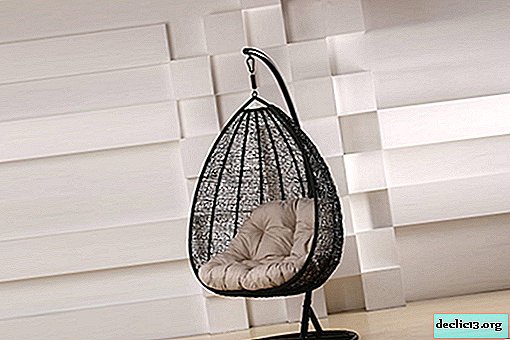Pests and diseases of streptocarpuses: photos and methods for their treatment

The exotic streptocarpus flower requires the special care of its owner. Sometimes you can notice that he becomes weak, has stopped in development, the leaves have become thinner. And the main plant is not entering the flowering phase.
After the owner of the flower tried to change the lighting, the place and frequency of watering, and the flower remained in the same condition, this indicates that the plant is affected by some kind of disease.
Consider in this article the main types of diseases and pests that affect the plant and how to treat ailments and fight parasites.
Guest from the tropics
Streptocarpus (lat. Streptocarpus) belongs to the Gesneriaceae familyin which about one hundred and thirty species. The birthplace of the flower is subtropical and tropical forests located on the slopes of the mountains of Thailand, the islands of Madagascar and South Africa. Some species like the drylands, while others prefer to hide in a shady forest. Streptocarpus can be both annual and perennial, both grassy and shrubby.
The leaves of the plant are slightly wrinkled and pubescent, reaching a length of 30 cm with a width of 5-7 cm. The color of the leaves can be either green or variegated in the cultivated varieties. Flowers are located on high peduncles that come out of the leaf sinuses. They have the shape of a bell with elongated lower petals of various colors: red, pink, purple, white, lavender, blue, two-tricolor.
The fruit of a streptocarpus is a twisted pod, because of it the plant got its name, because it is translated from ancient Greek as "twisted fruit". It contains flower seeds.Today, this flower is rapidly gaining its place among indoor plants, and plant lovers try to carefully observe the rules of maintenance and care when growing, but, Unfortunately, streptocarpus can be damaged by a disease or pest..
Common problems with descriptions and photos
Consider the main plant diseases that you can find when caring for it in photographs.
"Rusty" plaque on the leaves
Signs: brownish-gray pads that emit volatile spores located on leaves, stems, flower petals, petioles of leaf blades, seed boxes. Pads appear as yellow spots ("rust") on the leaves, gradually capturing the entire plant.
Reasons: excessive watering, planting density and excessive doses of fertilizing with nitrogen.
How to fight: in the early stages of the disease, infected shoots are cut and leaves removed. With an advanced disease, it is necessary to use fungicides: Abiga-Peak, Bactofit, Topaz, Fitosporin-M. The first treatment is carried out, at the first detection of "rust", and then it can be repeated after one to two weeks.

Leaves dry
Symptoms: the leaf became dry almost entirely in a short time
Reasons: the air is too dry in the room, the room has not been ventilated for a long time.
How to fight: remove dry leaves, periodically spray the plant and be sure to ventilate the room. So that in future the plant does not dry and feel comfortable, you need to try to maintain the optimum temperature and humidity in the room.

Leaf tips drying out
Signs: the leaves do not dry evenly, but in spots, and usually begin at the tip.
Causes: Too dry indoor air.
How to fight: cut off the dried ends with scissors, without squeezing the sheet, spray the air around the plant with waterso that moisture gets as little as possible onto the plant itself.

Streptocarpus does not bloom
Signs: the plant does not produce peduncles.
Reasons: leaf aging, each leaf gives no more than 6-10 peduncles, after which flowering ends.
How to fight: for the appearance of new leaves, flower division and transplantation into new larger pots is necessary, after this the problem is solved with the appearance of new leaves.

Pests and treatments for them
Thrips
This insect is small in size, almost invisible to the eye.
Signs: brown, dried, empty anthers; too fast flowering. On the petals of flowers, spilled pollen is visible.
How to fight:
- cut off all the buds and flowers on the plant;
- take one ampoule of Acarin (0.5 ml) per 0.5 liter of water;
- add 1 cap of zoo shampoo (for fleas and ticks);
- mix and carefully spray all streptocaptus with the resulting preparation;
- repeat two more times each after 7 days.
Akarin has a low risk to humans, it can be used at home.
Spider mite
IMPORTANT! The tick is a carrier of infectious diseases.Signs: upon examination of the lower part of the leaf, between the veins, an oily sheen is revealed, the surface is brownish. The sheet itself has a yellowish tint and dries out, starting from the edges.
How to fight: it is impossible to etch the tick with conventional insecticides, so we use modern acaricides: Sunmight, Nissoran, Apollo. For 1 liter of solution you will need 1 gram of Sunmight powder. This drug is a moderate hazard and can be used no more than 1 time per year.
With the use of Nissoran:
- 1 g Nisorana per 1 liter of water dilute the drug in water.
- Shake the spray gun.
- Spray the leaves from all sides.
 Effective until large populations of adult ticks appear.
Effective until large populations of adult ticks appear.
Using Apollo:
- 4 ml of Apollo is diluted in 10 liters of water. For this, we measure with a syringe 4 ml of the drug.
- Pour into a small container of water and add the contents of the syringe.
- To stir thoroughly.
- After this, pour the solution into a large container.
Processing with acaricides using personal protective equipment. After treatment, wash your face and hands with soap and rinse your mouth. Burn containers from the preparation without inhaling combustion products!
Aphid
Signs: a lot of white shells from the larvae on the plant, the leaves curl and have an unusual shape.
How to fight: aphids are susceptible to plants under constant stress (frequent transfusion or overdrying). The plant should receive enough water.
To prepare a solution from aphids, it is necessary to dilute 10 ml of Iskra Bio in 1 liter of water and carefully spray all streptocarpus plants 3 times with an interval of 7 days. As a rule, this is enough.ATTENTION! When processing plants indoors, choose biological products, or use folk remedies.
For example, an infusion of finely chopped onion (15 gr.) Or onion scales (6 gr.) Is suitable against a tick - insist in 1 l. water for 5-7 hours in a sealed container, then sprayed. From aphids, spraying with infusion of 100 g of dry citrus peel filled with 1 liter of warm water will help. Leave for three days in a warm place before spraying.
General rules for plant rescue
When a disease or pest is first detected, it is necessary to isolate the streptocarpus from the rest, in order to avoid the spread of the disease and begin treatment. It is better to put the plant on a separate window sill or shelf.
For preventive purposes, it can be treated with protective drugs. Fitoverm will do. Dissolve 2 ml of the drug in 200 ml of water and spray the house plant. Processing should be carried out every 5-8 days. Actofit and Kleschevit are also used.
Findings
Streptocarpus is exposed to common indoor plant diseases. It is necessary to observe watering regularity, not to overdry and not excessively moisten the soil, ensure the absence of direct sunlight, often ventilate the room and spray the air around the plant, all this will allow the plant to be resistant to diseases and pests.
In addition to observing the rules of plant maintenance, it is necessary to carry out prophylaxis against pests, for example, preparations of biological origin. If the plant is already affected, it must be isolated and treated.
















